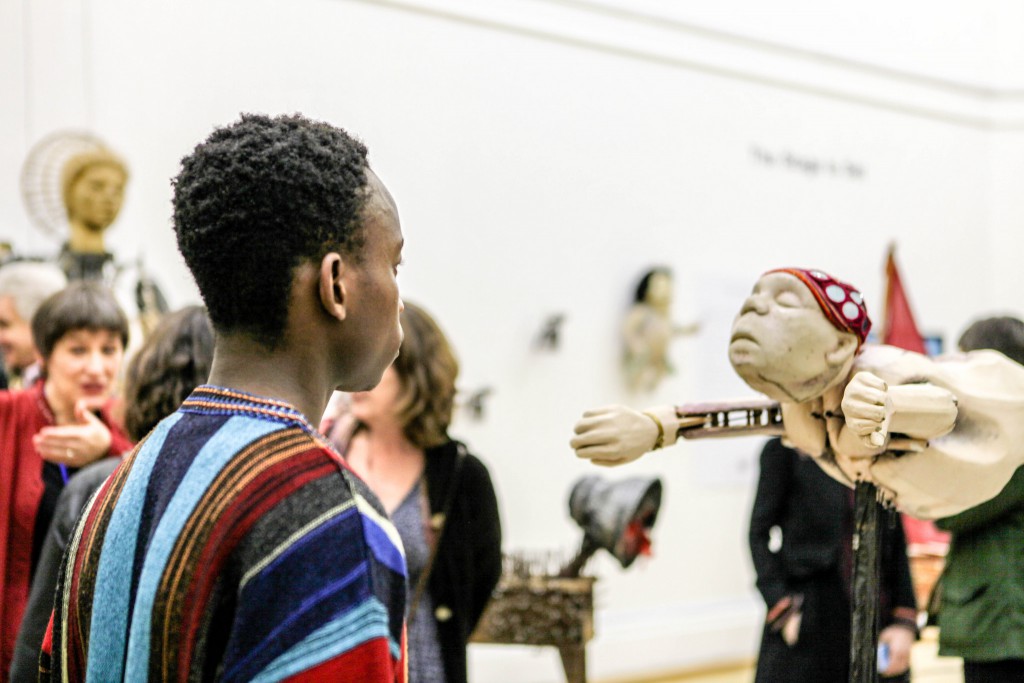
Centre Stage
Lights down, curtain up – theatre is an ephemeral art form, a moment of magic here and gone, reliant upon months (sometimes years) of collaboration between actors, directors, designers, producers and production team.
Yet, at the end of a performance, the scenery, props and costumes all remain – a reminder of the physical world created upon the stage. Centre Stage: Celebrating Theatre in Bristol, the free exhibition at the Royal West of England Academy that ran from 11 December 2015 to 24 January 2016, explored this materiality, turning the spotlight on those working in the wings and behind the scenes as well as the famous names on stage.
Visitors were invited to explore the worlds of two of the best known musical productions by theatre producer Cameron Mackintosh that have been staged in recent years at the Bristol Hippodrome – Mary Poppins and Phantom of the Opera (Mackintosh has a long association with the city since he staged his first production here, Little Women, in 1967); investigate the contributions of designers, scenic artists and costume makers in creating the art of illusion; discover ‘lost moments’ captured in a selection of intimate production photographs taken by Derek Balmer and Desmond Tripp over a period of four decades at the Bristol Old Vic; and immerse themselves in an artwork produced by Judith Aston that provided a glimpse into the captivating bond between audience and performer, A Theatre Within a Theatre.
Marking the 250th anniversary of Bristol Old Vic – Bristol’s longest running theatre – 70 years of the Bristol Old Vic Theatre Company, 70 years of the Bristol Old Vic Theatre School, 70 years of the Theatre Club and 65 years of the University of Bristol Theatre Collection, the exhibits on display were chosen to illuminate theatrical art and to celebrate the rich and complex history of theatre in Bristol.
Prior to the opening in 1766 of what is now known as the Bristol Old Vic in King Street, performances were held across the city in numerous spaces including a theatre below Brandon Hill in Jacobs Wells, which held its last performance – a pantomime – in 1779. A number of other theatres later sprang up in the city. These included the Regency Theatre on Prince Street in 1812; the New Theatre Royal on Park Row in 1867 (later becoming the Prince’s Theatre), which remained until its destruction in the Blitz; the Little Theatre in Colston Hall in 1923; and a number of musical and entertainment venues including the People’s Palace, the Empire, and the lavishly decorated Bristol Hippodrome which opened in 1912 and is still in operation today.
From the mid-nineteenth century, the Theatre Royal (now the Bristol Old Vic), suffered from mixed fortunes, due in part to its dockside location as well as theatrical competition, and, later, the widespread popularity of the moving image. It took until the mid-twentieth century for it to be re-established as a venue for serious drama and repertory theatre in the city.
Following the Second World War, the Council for Entertainment, Music and the Arts (later the Arts Council) invited the London Old Vic to organise a resident repertory company at the theatre, and in 1946 the Bristol Old Vic Company was formed, the same year that the Bristol Old Vic Theatre School opened. In 2016, to mark its 250th anniversary, the theatre will enter a new period of transformation, which will reconnect the theatre with King Street, including the stripping away and opening up of its current façade.
Bristol continues to thrive as a centre for theatre and is now also home to the renowned Shakespeare at the Tobacco Factory, the Tobacco Factory and Brewery Theatres, plus Acta Community Theatre, the Alma Tavern and Theatre, Redgrave Theatre, the Wardrobe Theatre and the Wickham Theatre, based at the University of Bristol. The University’s Drama Department was established in 1947, the first in the UK, and shortly after, in 1951, the Theatre Collection was founded. It is now recognised as one of the world’s leading archives of British theatre and live art.
Centre Stage provided the setting for the first in a series of Bristol 800 weekenders, part of the year-long programme of events and activities celebrating significant Bristol anniversaries dating back to the inauguration of the first mayor in May 1216. Special free events staged over the weekend included: gallery talks with Jo Elsworth (Director of the University of Bristol Theatre Collection), Derek Balmer (painter, photographer and former president of the RWA), and Judith Aston (creator of the Theatre Within a Theatre exhibit); The Secrets of Scenic Art, a session delivered by staff, students and alumni of Bristol Old Vic Theatre School; and an audience Q&A with Rachel Walker and Eleanor Smith, costumiers from Bristol Old Vic Theatre School.